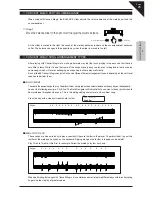
Page
35
RECORDER
4
Step4
Start to play the piano.
The recorder will automatically start recording with the fi rst note played.
During this time, the LED indicators for the REC and PLAY/STOP buttons will be turned on.
Any changes made to the sound while recording will also be recorded.
The recording can be started by pressing the PLAY/STOP button instead of pressing a key, allowing a blank bar
to be inserted at the beginning of a song.
Step5
Press the PLAY/STOP button to stop recording.
The LED indicators for the PLAY/STOP button and the REC button will turn off and the newly recorded part will
be saved to memory automatically.
Saving may take a few moments and during this time the piano will not perform any other operations.
To record the piece again, simply repeat the above procedure. The new recording will completely erase the previous
one.
The total recording capacity of the CN41 piano’s memory is approximately 15,000 notes, with button and pedal presses
also counted as one note.
When the maximum capacity is reached, recording will stop and all music recorded up until that point will be saved to
memory automatically.
Performance data stored inside the CN41 piano’s memory will be saved even after turning off the power.
Panel operations stored during recording:
x
Changes made to the sound type.
x
Shifts between DUAL and SPLIT modes.
Panel operations NOT stored during recording:
x
Changes made to effect settings – the selected effect will be applied to the selected sound type.
x
Changes made to tempo.
x
Changes made using the BALANCE slider in DUAL or SPLIT modes – the volume balance set immediately before
recording will be stored, however.
x
Turning the TOUCH CURVE or TRANSPOSE functions ON or OFF – regardless of the transpose settings the
performance will be replayed at the pitch originally used for the recording.






























